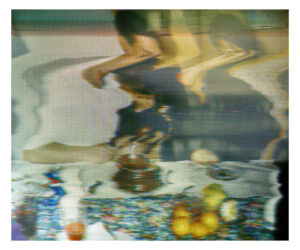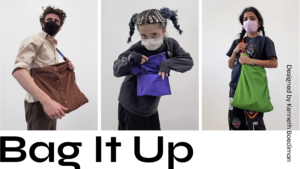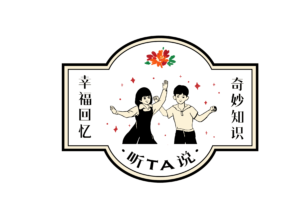Bahay Natin (Our House)
Fyonna Laddaran & Kin Godwin Chua
See it On Campus: Level 2
Visitor InfoWall installation is located just outside the library entrance. Interactive dining table installation is located in the library lobby.

A Celebration of Filipinx Stories, Culture, Creativity, & Community
Where it all began
The project Bahay Natin (Our House) began with an interest in discerning a connection between food and Filipinx resilience. Through academic journals and online articles, we gained a greater understanding of how colonialism and migration impacted Filipinx cuisine over several hundred years. We explored cuisine in the context of Spanish and American colonial occupation; local stories of immigration and food; and the ongoing rezoning plans affecting Filipinx restaurants in Vancouver’s Joyce-Collingwood neighbourhood (an important cultural hub for many Filipinx people in Metro Vancouver).


Reflecting on Filipinx-Canadian Identity
Leaning more into our shared Filipinx history and culture, we recognized how it has been heavily shaped by its relationship to American culture and/or reduced to themes of poverty and political corruption due to its reputation as a developing country (an antiquated term with problematic connotations of colonial hierarchies and stereotyped inferiority). Our project seeks to answer this question: “How do we begin to understand our place in the world as Filipinx-Canadians?”
Through conversations with local Filipinx-Canadian creatives, community advocates, and scholars* in Vancouver, we came to understand that the process of constructing and reconstructing one’s identity can be complex, nuanced, multi-faceted, and empowering.
*We feel honoured to have met and listened to so many incredible people, including JP Catungal, Claire Baguio, Kathleen Zaragosa, Una Gil, Donnel Garcia, and April Milne. The conversations we had and the stories we shared were some of our favourite aspects of our project.

Communal Eating + Storygathering
On the evening of November 19, 2021, we hosted a Kamayan or Boodle Fight dinner event at the Wellness Kitchen for our friends in the Design Faculty. Kamayan describes the method of eating food using only one’s hands; meanwhile, Boodle Fights are a particularly ritualized and communal version of Kamayan that came about during the American military occupation of the Philippines. Our intention in hosting this event was to experience a part of Filipinx culture that we (Kin and Fyonna) had yet to participate in and create a space of storygathering and community. Through the act of communal eating, we shared a new culinary experience with our friends and explored the deeper connections between food and resilience. This created a space where we could situate ourselves within a broader complex cultural setting, delving into the intersections of food, language, immigration, and identity.







A Gift Exchange
At its core, Bahay Natin is designed to encompass both sides of a gift exchange.
With our interactive exhibit on one side, we aim to share the gift of our culture and cuisine.
With our publication on the other side, we aim to show appreciation for all the
relationships and insights we’ve gained throughout the year.
Final Outcomes
Our final outcomes consist of a publication and a grad show exhibit. The publication includes transcribed interviews from our research phase, portrait photography of the interviewees, and a feature for our Filipinx peers in ECU. It plays with the idea of a metaphorical house where each feature represents unique “rooms” in which our interviewees can display their work and perspectives in. The grad show exhibit consists of a gift box set atop a dining table. The dining table display will include paper placemats that educate visitors about Filipinx food culture and a menu of conversations that took place during our Kamayan event. The gift box will include several takeaway items, from postcards and stickers that highlight snippets of Filipinx food culture, to food crawl zines that introduce readers to local Filipinx restaurants.


Dining Table + Balikbayan Box
Inspired by our Kamayan event, the concept for our deliverables comes from the idea of a dining table filled with gifts. In the center of our display, we use a box to hold all of our deliverables and to represent a popular artefact people use in the Filipinx diaspora to send gifts back home to their families. In Tagalog, it’s called a Balikbayan box, which translates in English to “balik” meaning return and “bayan” meaning country.
Our intention is to create an experience and space where audiences can situate themselves within a broader complex cultural setting, opening up conversations about the intersections of food, language, immigration, and identity.


Menu of Conversations
The Menu of Conversations captures the insights and discussions we had during our communal dining experience during the Kamayan event. By breaking down the event itself, we draw connections between the way Filipinx meals are consumed to its complex militaristic and colonialist histories.

Placemats
Placemats are a very common artefact you can find on most Filipinx tables during meal times. We designed these placemats to educate our audiences about the complexity of Filipinx food culture and its histories, including the eating tools we use, Kamayan’s history, flavour combinations we enjoy and the prevalence of rice in our diet.

Postcards
We created 2 sets of postcards to celebrate and highlight Filipinx culture. One of our sets was inspired by Chase Valencia’s characterization of palabok and other Filipino food as “deliciously excessive.” These illustrations depict different types of food stations commonly found in the Philippines. The other set of postcards revolves around prepaid phone cards, used by families separated across oceans. Combining that concept with iconic food packaging based in the Phillippines, we created something fun, yet nostalgic.

Zine
The final part of our gift box is a food crawl zine to introduce our attendees to local Filipinx restaurants. The zine isn’t a comprehensive list but it provides a good starting place for those who haven’t tried the cuisine yet and we hope it encourages them to look into the several other options we have nearby, from Filipinx restaurants to Filipinx convenient stores! Click here to see additional Google Maps results.
Publication
The publication aims to show our appreciation for all of the relationships and insights we gained throughout the year. It includes transcribed interviews from our research phase and portrait photography of each of our interviewees. Each interview section acts as a metaphorical room in Bahay Natin in which the featured interviewees express their ideas and their work. After the interviews, we have a feature of our Filipinx peers in Emily Carr and additional content that details other aspects of our project.






